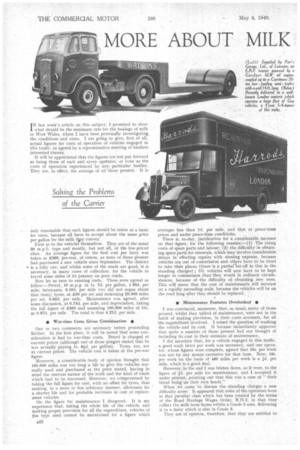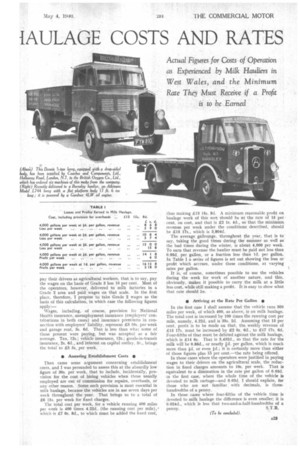- 4 11 .' 9 "....1 101 1 54 "Kalkeit MORE ABOUT MILK
Page 24

Page 25

If you've noticed an error in this article please click here to report it so we can fix it.
TAULAGE COSTS AND RATES
IN last week's article on this subject, I promised to show what should be the minimum rate for the haulage of milk in West Wales, where I have been personally investigating the conditions and costs. I am going to give, first .of all, actual figures for costs of operation of vehicles engaged in this traffic, as agreed by a representative meeting of hauliers interested therein.
It will be appreciated that the figures are not put forward as being those of each and eyery opeTator, or even as the costs of operation experienced by any particular haulier. They are, in effect, the average of all those present. It is only reasonable that such figures should be taken as a basis for rates, because all have to accept about the same price per gallon for the milk tlyy convey. First as to the vehicles themselves. They are of the usual 90 m.p.h. type and mostly, but not all, of the low-priced class. An average figure for the first cost per lorry was taken as £360, pre-war, of course, as none of those present had purchased a new vehicle since September. The district • is a hilly one, and whilst some of the roads are good, it is necessary, in many cases of collection; for the vehicle to travel some miles of its journey on poor roads.
Now let us turn to running costs. These.were agreed as follow:—Petrol, 10 m.p.g. at Is. 7d. per gallon, 1.90d. per mile; lubricants, 0.10d. per mile (we did not argue about that item) tyres, at 250 per set and reckoning 20,000 miles per set, 0.60d. per mile. Maintenance was agreed, after some discussion, at 0.75d. per mile, and depreciation, taking the full figure of £360 and assuming 100,000 miles of life, at 0.87d. per mile. The total is thus 4.22d. per mile.
Es War-time Costs Given Consideration •
One or two comments are necessary before proceeding farther. In the first place, it will be noted that some consideration is had to war-time costs. Petrol is charged at current prices (although one of those prewnt stated that he was actually paying Is. 8fd. per gallon). Tyres, too, are at. current prices. The vehicle cost is taken at the pre-war figure.
Moreover, a. considerable .body of opinion thought that 100,000 miles was too long a life to give the vehicles normally used and purchased at the price stated, having in mind the onerous nature of the work and the kind of roads which had to be traversed. However, we cotnpromised by taking the full figure for cost, with no offset for tyres, thus making, in a more or less arbitrary manner, allowance for a shorter life and for probable increases in cost of replacement vehicles.
On the figure for maintenance I disagreed. It is my experience that, taking the whole life of the vehicle, and making proper provision for all the expenditure, vehicles of the type used cannot be maintained for a figure which
averages less than Id. per mile, and that at peace-time prices and under peace-time conditions.
There is, to-day, justification for a considerable increase on that. figure, for the following reasons:—(1) The rising costs of spare parts and labour; (2) the difficulty in obtaining spare parts for renewals, which may involve considerable delays in effecting repairs with ensuing expense, because vehicles are out of commission and others have to be hired to take their places (there is a partial set-off to this in the standing charges) ; (3) vehicles will now have to be kept longer in commission than they would in ordinary circumstances, because of the difficulty of obtaining new ones. This will mean that the cost of maintenance will increase on a rapidly ascending scale, because the vehicles will be on the road long after they should be replaced.
se Maintenance Features Overlooked • I was convinced, moreover, that, as usual, many of those present, whilst they talked of maintenance, were not in the habit of making provision, in their costs accounts, for all the expenditure involved. I raised the question of washing the vehicle and its cost. It became immediately apparent that quite a number of those present had not thought of including its cost in their estimate of maintenance.
I did ascertain that, for a vehicle engaged in this traffic, a good wash twice per week was necessary, and one operator, whose figures were complete, agreed that 10s. per week was not by any means excessive for that item. Now, 10s. per week on the basis of 480 miles per week is a id. per mile, which is a good deal.
However, in the end I was beaten down, as it were, to the figure of Id. per mile for maintenance, and I accepted it under protest, pointing out that this was a case of " their blood being on their own heads."
When we came to discuss the standing charges a new difficulty arose. It appeared that some of the operators Were in that peculiar class which has been created by the terms of the Road Haulage Wages Order, R.H.2, in that they collect the milk from farms within a Grade 3 area, delivering it to a dairy which is also in Grade 3.
They are of opinion, therefore, that, they are entitled to pay their drivers as agricultural workers, that is to say, pay the wages on the basis of Grade 3 less 10 per cent. Most of the operators, however, delivered to milk factories in a Grade 2 area and paid wages on that scale. In the first place, therefore, I propose to take Grade 2 wages as the basis of this calculation, in which case the following figures apply:— Wages, including, of course, provision for National Health insurance, unemployment insurance (employers' contributions in both cases) and insurance premiums in connection with employers' liability, represent 23 10s, pee week and garage rent, 3s. 6d. That is less than what some of those present were paying, but was accepted as a fair average. Tax, 12s.; vehicle insurance, 12s.; goods-in-transit insurance, 2s, 641., and interest on capital outlay, 5s., brings the total to 25 5s. per week.
. • Assessing Establishment Costs • Then came some argument concerning establishment costs, and I was persuaded to assess this at the absurdly low figure of 305. per week, that to include, incidentally, provision for the cost of hiring vehicles when those usually employed are out of commission for repairs, overhauls, or any other reason. Some such provision is most essential in milk haulage, because the vehicles are in use seven days per week throughout the year. That brings us to a total of 26 15s. per week for fixed charges.
The total cost per week, for a vehicle running 400 miles per week is 400 times 4.22d. (the running cost per mile),. which is 27 Os. 8d., to which must be added the fixed cost, thus making 213 15s. 8d. A minimum reasonable profit on haulage work of this sort should be at the rate of 15 per • cent, on cost, and that is 22 Is. 4d., so that the minimum revenue per week under the conditions described, should be 215 17s., which is 3,804d.
The average gallonage, throughout the year, that is to say, taking the good times during the summer as well as the bad times during the winter, is about 4,000 per week. To earn that revenue the haulier must be paid not less than 0.9541, per gallon, or a fraction less than Id. per gallon. In Table I a series of figures is set out showing the loss or profit which accrues, under these conditions, at varying rates per gallon.
It is, of course, sometimes possible to use the vehicles during the week for work of another nature, and this, obviously, makes it possible to carry the milk at a little less cost, while still making a profit. It is easy to show what that rate should be.
• Arriving at the Rate Per Gallon • In the first case I shall assume that the vehicle runs 500 miles per week, of which 400, as above, is on milk haulage. The total cost is increased by 100 times the running cost per mile, namely, 4.22d, and is 35s. 241. Assuming that 15 per cent. profit is to be made on that, the weekly revenue of 215 17s, must be increased by 22 Os. 6d., to £17 17s. 6d. Four-fifths of that must be debited against the milk haulage, which is 214 6s. That is 3,43241., so that the rate for the milk will be 0.8641., or nearly d, per gallon, which is much more than id. or even ed.; it is certainly more than either of those figures plus 15 per cent.—the rate being offered.
In those cases where the operators were justified in paying wages to their drivers on the agricultural scale, the reduction in fixed charges amounts to 10s, per week. That is equivalent to a diminution in the rate per gallon of 0.0341. in the first case, where the whole time of the vehicle is devoted to milk cartage—and 0.03d. I should explain, for those who are not familiar, with decimals, is three. hundredths of a penny.
In those cases where four-fifths of the vehicle time is devoted to milk haulage the difference is even smaller; it is 0.024d., which is less that two-and-a-half-hundredths of a penny. S.T.R.




























































